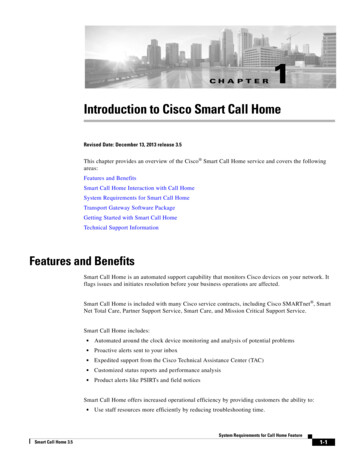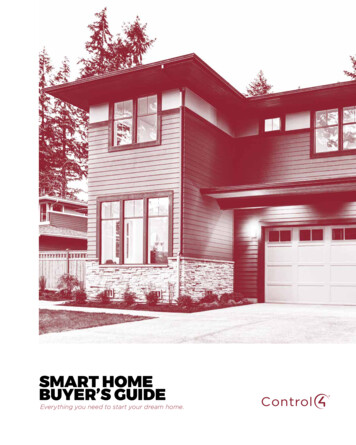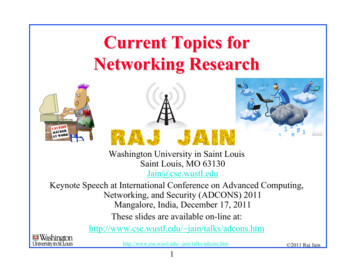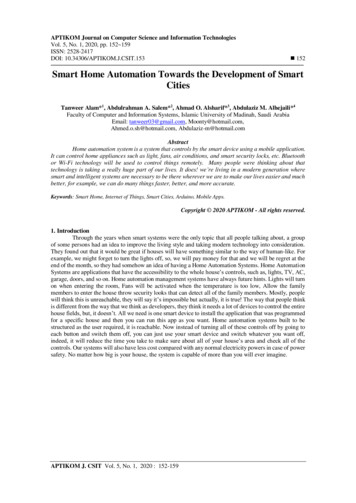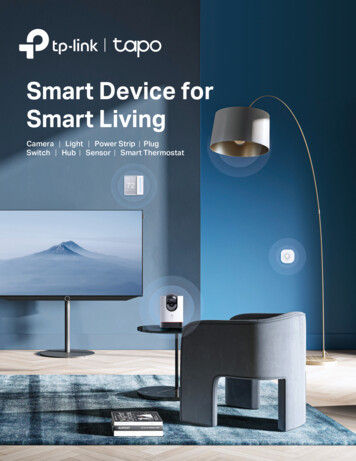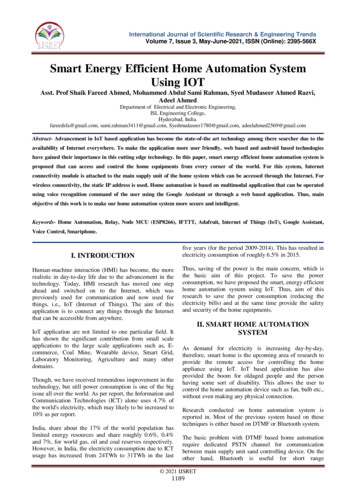
Transcription
International Journal of Scientific Research & Engineering TrendsVolume 7, Issue 3, May-June-2021, ISSN (Online): 2395-566XSmart Energy Efficient Home Automation SystemUsing IOTAsst. Prof Shaik Fareed Ahmed, Mohammed Abdul Sami Rahman, Syed Mudaseer Ahmed Razvi,Adeel AhmedDepartment of Electrical and Electronic Engineering,ISL Engineering College,Hyderabad, India.fareedsfa@gmail.com, sami.rahman3411@gmail.com, Syedmudaseer1780@gmail.com, adeelahmed2569@gmail.comAbstract- Advancement in IoT based application has become the state-of-the art technology among there searcher due to theavailability of Internet everywhere. To make the application more user friendly, web based and android based technologieshave gained their importance in this cutting edge technology. In this paper, smart energy efficient home automation system isproposed that can access and control the home equipments from every corner of the world. For this system, Internetconnectivity module is attached to the main supply unit of the home system which can be accessed through the Internet. Forwireless connectivity, the static IP address is used. Home automation is based on multimodal application that can be operatedusing voice recognition command of the user using the Google Assistant or through a web based application. Thus, mainobjective of this work is to make our home automation system more secure and intelligent.Keywords- Home Automation, Relay, Node MCU (ESP8266), IFTTT, Adafruit, Internet of Things (IoT), Google Assistant,Voice Control, Smartphone.five years (for the period 2009-2014). This has resulted inelectricity consumption of roughly 6.5% in 2015.I. INTRODUCTIONHuman-machine interaction (HMI) has become, the morerealistic in day-to-day life due to the advancement in thetechnology. Today, HMI research has moved one stepahead and switched on to the Internet, which waspreviously used for communication and now used forthings, i.e., IoT (Internet of Things). The aim of thisapplication is to connect any things through the Internetthat can be accessible from anywhere.IoT application are not limited to one particular field. Ithas shown the significant contribution from small scaleapplications to the large scale applications such as, Ecommerce, Coal Mine, Wearable device, Smart Grid,Laboratory Monitoring, Agriculture and many otherdomains.Though, we have received tremendous improvement in thetechnology, but still power consumption is one of the bigissue all over the world. As per report, the Information andCommunication Technologies (ICT) alone uses 4.7% ofthe world's electricity, which may likely to be increased to10% as per report.India, share about the 17% of the world population haslimited energy resources and share roughly 0.6%, 0.4%and 7%, for world gas, oil and coal reserves respectively.However, in India, the electricity consumption due to ICTusage has increased from 24TWh to 31TWh in the lastThus, saving of the power is the main concern, which isthe basic aim of this project. To save the powerconsumption, we have proposed the smart, energy efficienthome automation system using IoT. Thus, aim of thisresearch to save the power consumption (reducing theelectricity bills) and at the same time provide the safetyand security of the home equipments.II. SMART HOME AUTOMATIONSYSTEMAs demand for electricity is increasing day-by-day,therefore, smart home is the upcoming area of research toprovide the remote access for controlling the homeappliance using IoT. IoT based application has alsoprovided the boom for oldaged people and the personhaving some sort of disability. This allows the user tocontrol the home automation device such as fan, bulb etc.,without even making any physical connection.Research conducted on home automation system isreported in. Most of the previous system based on thesetechniques is either based on DTMF or Bluetooth system.The basic problem with DTMF based home automationrequire dedicated PSTN channel for communicationbetween main supply unit sand controlling device. On theother hand, Bluetooth is useful for short range 2021 IJSRET1189
International Journal of Scientific Research & Engineering TrendsVolume 7, Issue 3, May-June-2021, ISSN (Online): 2395-566Xcommunication that requires the operating appliance intheir range.Home automation using MQTT is presented in forsending/receiving data from the sensor. For thisRaspberrypi isused as a gateway for accessing the datafrom the sensor which are used to measure the temperatureand humidity of the room. An other home automationsystem is presented in which are based on Raspberrypi anduser can control their home appliance using the web-basedinterface. In, home automation using mobile is reported inwhich system is designed using ZigBee.IoT has provided the applications to turn non-smart deviceinto smart device, which allow users to access thesedevices through the Internet. It converts the home intosmart home and provides a more robust method ofcontrolling the home appliance. Also, the security can beadded with the help of installed camera in the home, whichcan be traced through the Internet. Thus, user can monitortheir home and can turn ON/OFF their appliances whichwill definitely going to save both the electricity andelectric bills.Other features that can be included in the smart home forsecurity purpose is to include the sensors and cameras thatcan prevent the intruder from entering into your home.Also, making the system more intelligent, that can turn onthe light and fan of the room as soon as it detects thepresence of the person.With this motivation, we develop IoT based homeautomation system which uses voice as well as web-basedservice for controlling the home appliance. Also forsecurity purpose, the user-define command are set whichenables to operate the system.The advantage of multi modal is that in the presence of thenoisy back ground surrounding the performance oftheGoogle assistance degrades. Hence, in such scenario webbased application can be helpful in controlling theappliance of the system. Thus, the proposed model isdesigned to provide better flexibility and making thesystem more robust. Figure 1 shows the generalarchitecture of the smart home automation system.As shown in the Figure 1 the smart home can beimplemented with main controller unit (Main switching ofthe home circuit) that is connected with the 24-houravailable Wi-Fi network. To ensure, that the Wi-Ficonnection do not turn off, the main controller isprogrammed to establish automatic connection with theavailable network and connected to the auto powerbackup.Further, the sub-units are connected with the maincontroller so that the devices which are not smart (here inthis case we are referring to the old home appliancesystem) can be turned into the smart appliance. Thus, userscan access and controlled their smart home using Googleassistant and web based service using an IoT basedapplication that uses Ada fruit and IFTTT to maintain thecommunication link.1. System Requirement: 4 NODE SMART SWITCH (main controller)integrated Wi-Fi Modude (ESP8285) SMPS (12v,24v) Amazon Alexa Relay ModuleFig 1. Smart home automation system architecture.III. SYSTEM DESIGN ANDIMPLEMENTATIONSpeech is one of the most important inputs used for manmachine interaction [32]. Therefore, to make smart homemore user friendly, Google assistance along with webbased application can be used to control the home system.Node Mcu (ESP8266) is an open source firm ware thatprovides the flexibility to build the IoT based application 2021 IJSRET1190
International Journal of Scientific Research & Engineering TrendsVolume 7, Issue 3, May-June-2021, ISSN (Online): 2395-566X[33]. Node Mcu has gained its popularity due to its lowcost and Wi-Fi enabled features. It also provides the Nodejs, that require less computation time to perform the taskand use Lua script. Thus making the device to operatemuch faster and making it as a first choice for IoTapplications.IFTTT stands for “If This Then That”, is an interfacewhich provide the web based service in which device areconnected with the mobile application [34]. Thus, makingit much easier for the device to work based on the mobileapplication using the conditional statements.Ada fruit is alibrary that supports the MQTT (MessageQueue Telemetry Transport) [28], [35]. It acts as anMQTT broker. MQTT is based on protocol service thatprovide the sending and receiving of the feed data. Theadvantage of MQTT is that it provides a faster rate oftransmission of the data and require less data byte for theconnectivity. It requires 80 bytes for establishing theconnection between the device to the server and 20 bytesfrom server to device. Arduino IDE software isused tocompile the code [36].Fig 3. Internal architecture of the controller unit.2.Working Models:The working of the smart home automation is shown inFigure2. As shown, initial requirement is the Internetconnectivity to access your smart home. One can accesstheir smart home either through the web based service orthrough Alexa.Fig 4. Prototype model of control unit along with the homeequipments.Initially, Amazon Alexa isused for controlling/monitoringour smart home and incase of noisy background homeautomation can be connected through web based service.For security purpose we have provided the user accesscode that will be asked by the Google assistant to verifywhich will prevent unauthorized smart home access.After successful connection, users will be able to accesstheir smart home appliance using an IFTTT statementcommand. It will be accessed through the Ada fruit forcreating the connectivity between the Google assistant andthe Node Mcu which is the main control unit of the smarthome automation. The home appliance is connected to themain controller unit with the sets of relay. The functions ofthese relays are to act as an ON/OFF switch on the maincontrol unit.Fig 2. System flow on the smart home automation systemusing Google assistan.In this paper we have shown the example of the maincontrol unit that we have designed for your smart home.Figure3 shows the connection of the main unit with theNodeMcu. For continuous operation of the circuit, powerbackup is also provided with the help of rechargeablebattery. 2021 IJSRET1191
International Journal of Scientific Research & Engineering TrendsVolume 7, Issue 3, May-June-2021, ISSN (Online): 2395-566XFinally, with the help of Amazon Alexa, based on the usercommand the home appliance can be turned ON/OFF withthe help of the designed system as shown in Figure5. Here,we have shown the example of turning the three bulbs.However, any home appliance can be connected throughthe proposed control unit.[8]IV. CONCLUSIONIn this paper, we have presented the step-by-step [9]procedure of smart home automation controller unit. Withthe help of the design control unit, home appliance can beconverted into a smart and intelligent device using IoT.The working of the proposed model was experimentallyshown with help of connecting the three bulbs. Proposed [10]system has two advantages.First, using the IoT connectivity, we can monitor andaccess our smart home easily from anywhere, which willdefinitely will prove to be energy efficient. Secondly, it act [11]has a helping hand for the oldage and differently abledperson. For future work we would like to add up morecontrolling units that can make our smart home moreintelligent that can be practically deployed in the real timesituation.[12]REFERENCES[1] P. Damacharla, A. Y. Javaid, J. J. Gallimore and V.K. Devabhaktuni, ”Common Metrics to BenchmarkHuman-Machine Teams (HMT): A Review,” in IEEEAccess, vol. 6, pp. 38637-38655, 2018.[2] O. Benderius, C. Berger and V. Malmsten Lundgren,”The Best Rated HumanMachine Interface Designfor Autonomous Vehicles in the 2016 ions on Intelligent Transportation Systems,vol. 19, no. 4, pp. 1302-1307, April 2018[3] Z. Xu, R. Wang, X. Yue, T. Liu, C. Chen andS. Fang, ”FaceME: Face-to-Machine ProximityEstimation Based on RSSI Difference for MobileIndustrial HumanMachine Interaction,” in IEEETransactions on Industrial Informatics, vol. 14, no. 8,pp. 3547-3558, Aug. 2018.[4] S. Ziegler, S. Nikoletsea, S. Krco, J. Rolimand J. Fernandes, ”Internet of Things and crowdsourcing - a paradigm change for the research on theInternet of Things,” 2015 IEEE 2nd World Forum onInternet of Things (WF-IoT), Milan, 2015, pp. 395399.[5] J. Voas, B. Agresti and P. A. Laplante, ”ACloser Look at IoT ’s Things,” in IT Professional,vol. 20, no. 3, pp. 11-14, May./Jun. 2018.[6] Q. F. Hassan, ”Introduction to the Internet of Things,”in Internet of Things A to Z: Technologies andApplications , IEEE, 2018.[7] S. Singh and N. Singh, ”Internet of Things (IoT):Security challenges, business opportunities &[13][14][15][16][17][18][19][20]reference architecture for E-commerce,” 2015International Conference on Green Computing andInternet of Things (ICGCIoT), Noida, 2015, pp.1577-1581.P. Kunkun and L. Xiangong, ”Reliability Evaluationof Coal Mine Internet of Things,” 2014 InternationalConference on Identification, Information andKnowledge in the Internet of Things, Beijing, 2014,pp. 301-302.A. J. Jara, “Wearable Internet: Powering PersonalDevices with the Internet of Things Capabilities,”2014 International Conference on Identification,Information and Knowledge in the Internet of Things,Beijing, 2014, pp. 7-7Q. Wang and Y. G. Wang, ”Research on PowerInternet of Things Architecture for Smart GridDemand,” 2018 2nd IEEE Conference on EnergyInternet and Energy System Integration (EI2), Beijing,2018, pp. 1-9.T. Sun, Y. Xu, J. Li and H. Zhang, ”Research onInternet of Things Middleware Technology forLaboratory Environmental Monitoring,” 2018International Conference on Virtual Reality andIntelligent Systems (ICVRIS), Changsha, 2018, pp.544-547.Q. F. Hassan, ”Internet of Things Applicationsfor Agriculture,” in Internet of Things A to Z:Technologies and Applications , IEEE, 2018.Y. Hsieh, ”Internet of Things Pillow DetectingSleeping Quality,” 2018 1st International CognitiveCities Conference (IC3), Okinawa, 2018, pp. 266267.Q. F. Hassan, ”Implementing the Internet ofThings for Renewable Energy,” in Internet of ThingsA to Z: Technologies and Applications , IEEE, 2018.X. Li, P. Wan, H. Zhang, M. Li and Y. Jiang,”The Application Research of Internet of Things toOil Pipeline Leak Detection,” 2018 15th InternationalComputer Conference on Wavelet Active , Chengdu, China, 2018, pp. 211-214.F.A. Rachman, A. G. Putrada and M. Abdurohman,”Distributed Campus Bike Sharing System Basedon Internet of Things (IoT),” 2018 6th InternationalConference on Information and CommunicationTechnology (ICoICT), Bandung, 2018, pp. 333-336.World Energy Resources, Technical Report, WorldEnergy Council , 2016.World Energy Outlook Executive Summary,Technical Report, International Energy Agency(IEA), 2017.E. Gelenbe and Y. Caseau, “The impact ofinformation technology on energy consumption andcarbon emissions,” Ubiquity, Association forComputing Machinery (ACM) 2015 (June), pp. 1-15.Draft National Energy Policy NITI Aayog,Government of India, 2017. 2021 IJSRET1192
International Journal of Scientific Research & Engineering TrendsVolume 7, Issue 3, May-June-2021, ISSN (Online): 2395-566X[21] Y. Kung, S. Liou, G. Qiu, B. Zu, Z. Wang andG. Jong, ”Home monitoring system based internet ofthings,” 2018 IEEE International Conference onApplied System Invention (ICASI), Chiba, 2018,pp. 325-327.[22] Y. Sun, Y. Xia, H. Song and R. Bie, ”Internet ofThings Services for Small Towns,” ation and Knowledge in the Internet of Things,Beijing, 2014, pp. 92-95.[23] D. Pavithra and R. Balakrishnan, “IoT basedmonitoring and control system for homeautomation,”Global Conference on CommunicationTechnologies (GCCT), Thuckalay, 2015, pp. 169-173.[24] H. V. Bhatnagar, P. Kumar, S. Rawat and T.Choudhury,“Implementation model of Wi-Fi basedSmart Home System,”International Conference onAdvances in Computing and CommunicationEngineering (ICACCE), Paris, 2018, pp. 23-28.[25] M. C. Domingo, “An overview of the Internet ofThings for people with disabilities,” Journal ofNetwork and Computer Applications, vol. 35, Issue2, pp. 584-596, 2012.[26] A. Olteanu, G. Oprina, N. Tapus and S. Zeisberg,“Enabling Mobile Devices for Home AutomationUsing ZigBee,” 19th International Conference onControlSystemsandComputerScience,Bucharest, 2013, pp. 189-195.[27] R. Piyare and M. Tazil, “Bluetooth based homeautomation system using cell phone,” 2011 IEEE15th International Symposium on ConsumerElectronics (ISCE), Singapore, 2011, pp. 192-195[28] Y. Upadhyay, A. Borole and D. Dileepan,“MQTT based secured home automation system,”Symposium on Colossal Data Analysis andNetworking (CDAN), Indore, 2016, pp. 1-4[29] T. Wang, Y. Li and H. Gao, ”The smart homesystem based on TCP/IP and DTMF technology,”2008 7th World Congress on Intelligent Controland Automation, Chongqing, 2008, pp. 7686-7691.[30] T. M. Ladwa, S. M. Ladwa, R. S. Kaarthik, A. R.Dhara and N. Dalei, ”Control of remote domesticsystem using DTMF,” International Conferenceon Instrumentation, Communication, InformationTechnology, and Biomedical Engineering 2009,Bandung, 2009, pp. 1-6.[31] N. M. Morshed, G. M. Muid-Ur-Rahman, M. R.Karim and H. U. Zaman, ”Microcontroller basedhome automation system using Bluetooth, GSM,Wi-Fi and DTMF,” 2015 International Conferenceon Advances in Electrical Engineering (ICAEE),Dhaka, 2015, pp. 101-104.[32] P. Upadhyaya, O. Farooq and M. R. Abidi “MelScaled M-band Wavelet Filter Bank for SpeechRecognition,” International Journal of SpeechTechnology, vol. 21, no. 4, pp. 797-807, 2018. 2021 IJSRET1193
The working of the smart home automation is shown in Figure2. As shown, initial requirement is the Internet connectivity to access your smart home. One can access their smart home either through the web based service or through Alexa. Fig 2. System flow on the smart home automation system using Google assistan. Fig 3.
